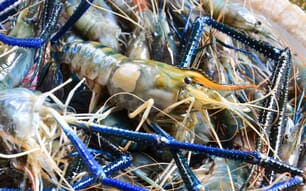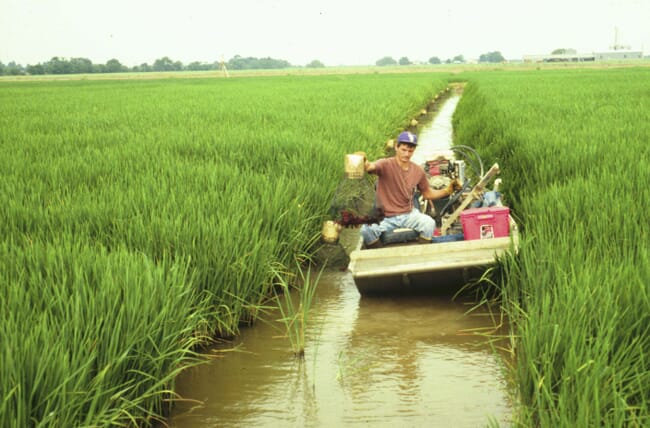
© C Greg Lutz
Although management practices can be easily changed from year to year, trying to change ponds that were poorly designed and improperly constructed can be expensive. Seek advice from your local LSU AgCenter extension agent and area United States Department of Agriculture (USDA) Natural Resources Conservation Service engineer prior to beginning construction.
Location
Crawfish ponds should be located in flat, open areas, and the soils should have sufficient amounts of clay. Adequate water sources should be available. Clay loams, sandy clay loam and silty clay loams are satisfactory soil types. A clay soil is necessary to hold water and to maintain the integrity of crawfish burrows. Generally, soils that can be rolled into a ball have enough clay for crawfish culture. Elevations must be sufficiently high to allow the pond bottom to remain above water levels in the surrounding drainage ditches and canals (Figure 1).

For rice-field ponds, sites are usually limited to existing rice fields. Even so, consideration of which fields will be placed in crawfish production is important. Because of the labor intensive operations of crawfish farming, many rice farmers typically commit only 10 per cent to 50 per cent of their total rice acreage to crawfish. Often the best producing rice fields are not selected for rotation with crawfish. It is important to select rice fields with adequate all-weather access because crawfish harvesting and pond management are daily activities and often occur during wet weather. Fields selected for crawfish production should have accessible and economical water supplies because the water requirements for crawfish farming are higher than for rice production.
Field size and layout may be an important consideration when producing crawfish on rice acreage. Trapping lanes are more efficient when long and straight, and levee crossings should be kept to a minimum. Limited access for vandals and thieves may be an important consideration. Consideration of the positioning of fields destined for crawfish production may also be important from a pesticide perspective. Positioning of crawfish ponds between producing agronomic fields, or downwind from a field where aerial application of an insecticide is planned is not prudent.
Design and construction
A number of considerations should be taken into account when constructing permanent crawfish ponds. Many of these also apply to rice fields that are intended for crawfish production. Perimeter levees should have a core trench cleared of debris to prevent water seepage. The minimum perimeter levee base should be 9 feet wide to prevent leakage from the burrowing activities of the crawfish. A levee system 3 feet high is adequate to contain the minimum 8 to 12 inches of water necessary to cultivate crawfish. The land should have no more than a 6-inch fall between perimeter levees. Otherwise, the area should be leveled or divided into two or more ponds. Ponds with steep elevations and resulting depth variations hinder forage establishment, restrict water management techniques and reduce harvesting efficiency.
Wide and deep interior ditches inside crawfish ponds, which are usually adjacent to large perimeter or large baffle levees, should be avoided where possible. These deep areas provide a pathway of least resistance for water flow that can reduce circulation in other areas of the pond, potentially causing poor quality and reduced catch in areas away from the ditches. Additionally, interior ditches are difficult to drain, and they may serve as a refuge for predatory fish after ponds are drained. Interior or baffle levees are constructed to guide water through the pond for proper aeration and to help maintain proper water quality (Figure 2).
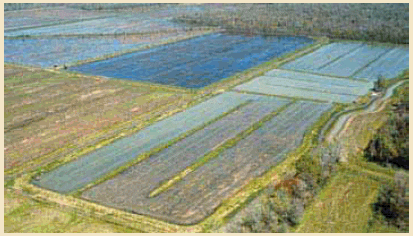

Baffle levees are built about 6 feet wide at the base. They should extend a minimum of 6 inches above the expected water level for the pond. If the part of the baffle levees above the water line is not substantial enough, settling and erosion will cause the levees to breach in one or two years. Baffle levees should be spaced 150 to 300 feet apart to facilitate water circulation. Core trenches in the baffle levees are not necessary. A recirculation canal outside the perimeter levee and a re-lift pump will aid in water circulation and minimize water discharge (Figures 3 and 4). Ponds designed to recirculate water are important in areas where the quality of the surface water supply fluctuates or where well water must be pumped from great depths at great cost.
Drains should be matched with the pond size, pumping capacity and projected rainfall (Figure 5). Two 10-inch drains are sufficient to drain a 20-acre pond. Ponds must allow vehicle access in wet and dry conditions and allow efficient use of harvesting equipment.
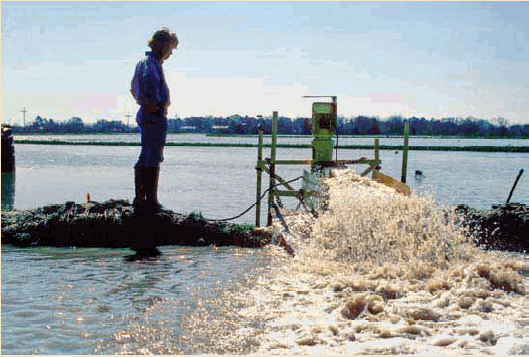
Most often, crawfish ponds in a rice-crawfish rotational system use established rice fields where the field lay out and irrigation systems are fixed. Some modifications of the field may be necessary, however, for best results with crawfish. Small levees that are adequate for rice production in shallow waters (less than 5 to 6 inches deep) are not adequate for crawfish production where water levels are usually maintained at 8 to 16 inches. Larger levees are especially critical for the perimeter, which hold in water. Whereas rice production requires a water holding period of 8 to 10 weeks, crawfish ponds are usually flooded for 7 to 10 months. Settling, erosion, burrowing rodents and crawfish burrowing can take their toll on small levees. Therefore, rice fields destined for crawfish production usually require much taller and wider levees. It should be noted though that levee construction/reconstruction should occur before introduction of crawfish broodstock because levee renovation after crawfish have burrowed can reduce broodstock survival and reproduction.
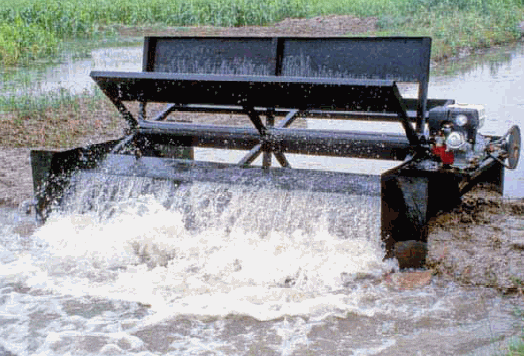
Levees can also act to keep flood waters out of a crawfish pond at times. Breached levees from flood waters can disperse crawfish out of the pond and introduce unwanted fish into the pond. With electronic laser leveling, some rice fields have become very large with few or no interior levees. If too large, these fields may possess a ratio of linear levee to total pond area that is too large for optimal reproduction, because crawfish use the levees as burrowing sites. Conversely, the presence of too many interior levees potentially provides excess reproductive burrowing area and can lead to overpopulation and stunted crawfish. The optimal levee-to-pond area ratio has not been determined and varies with geographic location and other conditions.
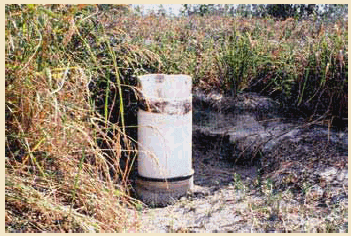
Rice-field water irrigation is usually designed to achieve efficient water output with little concern for maximising oxygen content of the water. Therefore, it is recommended that water discharge outlets on irrigation wells be modified to include aeration screens to maximise oxygen input to provide for the highest quality of water in fields where crawfish are to be grown.
Best management practices for crawfish pond construction
A set of best management practices (BMPs) for crawfish production has been developed in cooperation with the USDA Natural Resources Conservation Service (NRCS). (See summary in Table 4.) These practices seek to minimise erosion, reduce the amount of contaminants (nutrients and pesticides) in effluent discharges and maximise the benefit to wildlife.
Table 4. Summary of United States Department of Agriculture National Resource Conservation Service (NRCS) Best Management Practices for Crawfish Pond Design and Construction. |
||
|---|---|---|
| Conservation Practice | NRCS Code | Comments |
| Access road | 560 | Necessary for daily transportation to crawfish ponds for water management, forage management, harvesting and marketing crawfish. May impede natural runoff. May contribute to siltation if not properly vegetated. May reduce wetland habitat. |
| Brush management | 314 | May be required to plant forage and to develop harvesting lanes. Physical removal may cause temporary turbidity problems. Labeled use of herbicides would not have a significant environmental impact. |
| Channel vegetation | 322 | Turbidity caused by unvegetated channels may contribute to sedimentation problems. Vegetated channels help turbidity problems and improve water quality pumped into ponds. |
| Crop residue use | 344 | Natural vegetation may be allowed to grow before preparing for forage production to reduce erosion during interim of draining and planting forage. Provides habitat for wildlife. Cover improves soil moisture and should improve conditions for crawfish in burrows. |
| Filter strips | 393 | Provide a means of reducing sediment in inflow and discharge water where practical. May reduce soil erosion. |
| Fish pond management | 399 | Crawfish ponds used to produce crawfish commercially. Depth and forage production differ from typical fish ponds. Provides positive impact on the environment. Provides habitat for many forms of wildlife, such as wading birds, waterfowl and many furbearers. |
| Irrigated field ditch | 388 | Another effective irrigation tool that promotes good water management and conservation. Provides pathway for water from source to ponds. |
| Irrigation water management | 449 | Planned irrigation, flooding and draining to manage forage and crawfish. |
| Wells | 643 | Well water recommended over surface water. |
| Wetland development | 657 | Flooded crawfish ponds greatly benefit and improve the quality of the water entering and exiting the field in most cases. Crawfish ponds and production have a positive impact on the environment. |
| Wildlife wetland | 644 | Crawfish ponds provide more than 120,000 acres of manmade wildlife wetland habitat that greatly benefits waterfowl, wading birds, gallinules, shorebirds, furbearers, reptiles, amphibians and numerous invertebrate animals that benefit other species of wildlife. |
February 2010

